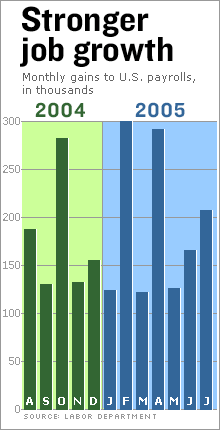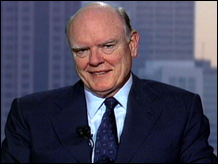 |
|
|
|
|
|
|

|
| Treasury Secretary John Snow shares his view on the U.S. economy and latest job numbers. |
Play video
|
|
|
|
|
|
NEW YORK (CNN/Money) -
In a robust sign for the nation's economy, employers added more jobs to U.S. payrolls in July than expected, the government reported Friday.
But along with the job surge came higher wages, fanning concerns about higher interest rates and spooking markets.
The better wage reading was part of a closely watched Labor Department report that showed solid gains in the labor market -- 207,000 jobs added to U.S. payrolls, fed mostly by significant job growth in the service sector.
But the average hourly wage increased 6 cents, or 0.4 percent, to $16.13. That was about twice the jump forecast by economists.
Wachovia Securities' Chief Economist John Silvia said additional quarter-point rate hikes are now virtually assured for at least the next three Federal Reserve meetings, due to rising labor costs that could force companies to raise prices or accept thinner profits.
"Labor costs were one of the key inflation concerns cited by Chairman (Alan) Greenspan in his latest testimony," said Silvia. "Our outlook reinforces his concern."
Treasury prices fell and the 10-year note yield, which moves in the opposite direction, soared to 4.40 percent in early afternoon trading from 4.31 percent before the report, on concerns about what the wage data would mean to the Fed, whose next interest rate meeting is set for Tuesday.
Stocks were lower throughout the morning and into early afternoon trading Friday on the rate concerns, after futures had pointed to a higher open before the report.
"We have had an extraordinary period of job growth the last four months," said Drew Matus, senior economist with Lehman Brothers. "The bond market is always worried about higher growth, and the equity market is concerned that the Fed might be more likely to overshoot, and take rates too high."
It is widely expected that the Fed will raise rates by a quarter-percentage point for the tenth straight meeting. But with other government reports showing inflation in check, some had hoped the central bank would signal it is getting closer to pausing in its pace of measured rate hikes.
The strong wage number, while only one month's result, could lessen the chance of that signal.
Richard Yamarone, director of economic research for Argus Research, said he would not be surprised to see the Fed get more aggressive with a half-point rate hike at its September meeting.
Other economists agreed the dark lining in Friday's silver-plated report was higher short-term interest rates.
"With this figure, markets can remain all but assured that the Fed will continue to push short term rates higher well into 2006," said Anthony Chan, senior economist with JP Morgan Fleming Asset Management.
Over the last 12 months, average hourly wages and weekly wages are now up 2.7 percent, slightly more than the 2.5 percent rise over the 12 months ending in June reported in the Consumer Price Index, the government's key inflation report.
Gains in service sector jobs
July's 207,000 job gain compared with a revised 166,000 increase in June. Economists surveyed by Briefing.com forecast an increase of 180,000 in the most recent month.
The June job gain was revised up 20,000 from the initial reading, and the May reading was also revised up 22,000 jobs to a gain of 126,000.
The job growth in the report was cheered by Treasury Secretary John Snow.
"This is a broad-based job recovery. Teenagers benefited. Minorities benefited," he told CNN Friday morning. "The numbers indicate the American economy continues to be on a good, strong path."
The unemployment rate remained at the 5 percent level reached in June. Economists had forecast that the rate would remain unchanged.
The unemployment rate is calculated using a separate survey of households, rather than the employer survey used to calculate the payroll number that's more closely watched by economists.
The household survey showed an even larger gain in the number of people working, up 438,000, with that survey now showing nearly a 400,000 job gain average over the last four months, or about twice the gain reported in the employer survey.
But the latest household survey also showed a large jump in the number of people who are counted as a part of the labor force, as some workers who had left the labor market returned. So even with the big jump in jobs reported in that survey, the number of unemployed also edged up slightly, which kept the unemployment rate unchanged.
As to the breakdown by sector, the employer survey showed that service sector jobs were responsible for nearly all the gain in payrolls, with 203,000 jobs added there. Retail trade added 50,000 of those jobs, with clothing stores responsible for a quarter of that gain and general merchandise retailers adding another 10,000.
Both the business and professional service category as well as the leisure and hospitality industries added 33,000 a piece.
Wachovia's Silvia said about 60 percent of industries tracked by the employer survey showed gains, which suggests underlying strength for both the labor market and the economy as a whole.
There were some signs of weakness, though. The embattled airline industry lost about 3,000 jobs despite the busy summer travel season and strong demand for travel. There was only a 7,000 gain in construction jobs in a booming home building market.
Manufacturing jobs retreated by 4,000, led by nearly an 11,000 job drop at the nation's auto plants. But auto dealers added nearly 6,000 workers to handle the flood of buyers drawn by low price offers from the nation's three largest automakers.
For more on the labor market and what it means for you, the economy and markets, click here.

|